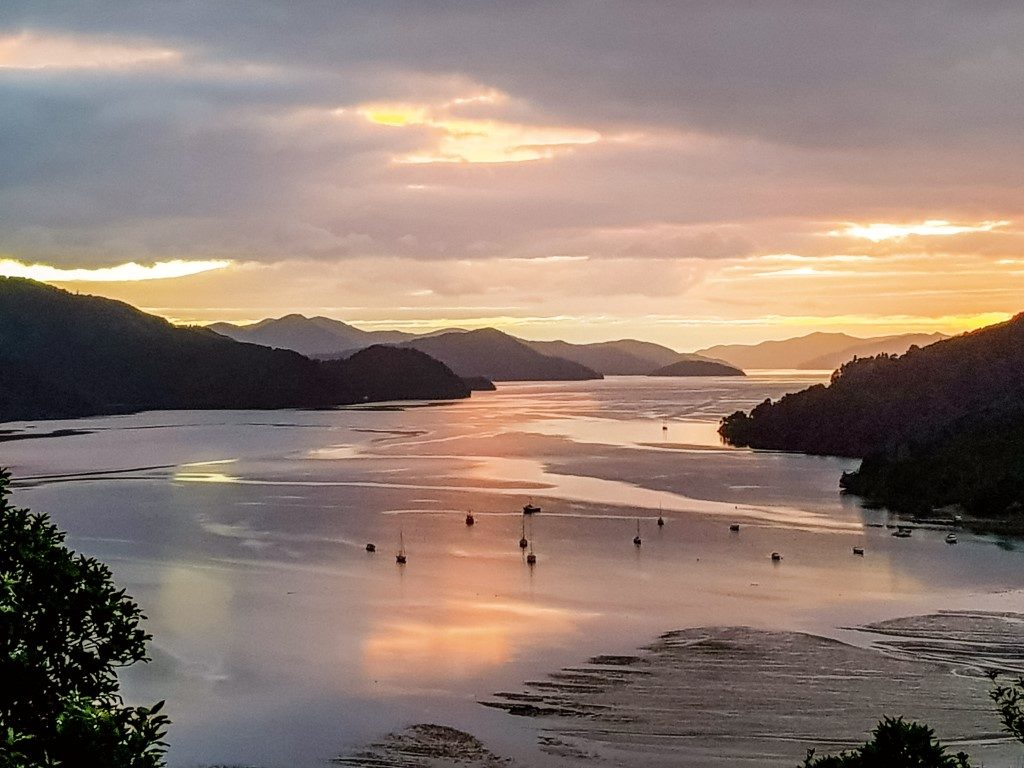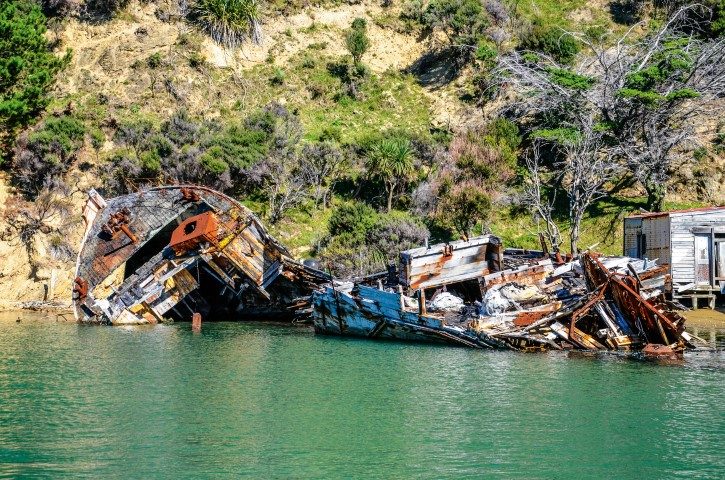

First – a confession. I like to think I’ve sailed extensively in the Marlborough Sounds. That’s only half-true. In reality – I’ve sailed within the Queen Charlotte Sound. And there’s no denying its majesty and appeal – breathtaking scenery, idyllic anchorages, great fishing, fun restaurants, exceptional wine. Story by Lawrence Schaffler.

But the ‘Sounds experience’ changed for me earlier this year when I ventured into the Pelorus Sound – often described as Charlotte’s more demure, retiring sister – for the first time. It is – in my opinion – even more beautiful and much more interesting.
It comes with all the attractions listed above but, perhaps because of its relative isolation, the deafening silence, the star-studded night skies, the expansive waterways and hidden inlets – there’s a greater mystique. With its 380km shoreline, it is the largest of the Sounds and its name derives from a ‘blend’. In 1838 HMS Pelorus did the first survey of the Sound – and a ‘pelorus’ is a navigational accessory used on early sailing ships.
An extraordinarily convoluted (think maze) boating playground, it would take weeks if not months to adequately explore its waterways, inlets and anchorages. But the best-kept secret of the Pelorus Sound is that you don’t even need a boat to dip into its treasures. Instead, hop aboard the Pelorus Express mail boat.

This service – celebrating its centenary this year – was originally established to deliver mail (and supplies and livestock and pretty much anything else) to the locals living in some of the Sound’s remotest outposts. A century ago, it was a much busier place, and over the years has hosted whalers, miners, saw-millers, shipbuilders and farmers.
Today those industries have (mostly) disappeared and have been replaced by the country’s largest mussel farming industry. What’s remained largely unchanged though, is that there are (still) very few access roads and hardly any on-grid electricity. For many places a boat is (still) the only means of access.

Fortunately, the mail boat operating today is much more modern (and a lot faster) than the vessels that plied the Sound a century ago. She’s brand new – a fast, stable 15m alloy catamaran equipped with twin 600hp diesels. She runs seven days a week in summer (three in winter) and, in the words of her crew, her service has morphed over the years.
Says Jim Baillie, the boat’s infectiously-upbeat owner/skipper and walking-Pelorus-Sound-encyclopaedia: “We used to be a mail service boat carrying a few tourists. Today we’re a tourist boat carrying a bit of mail.” Baillie is the ninth owner of the operation. The new cat is a birthday present, he says, to celebrate the service’s centenary.
Based at Havelock Marina at the head of the Sound, she’s the day-tripper’s key to discovering Pelorus Sound. With her speed she covers the entire Sound, leaving at 10.00am and returning at around 4.00pm. And it’s an enormously enjoyable voyage.
More than a Mail Boat
The boat’s a glorious platform for taking in the sights through the Sound – presenting vistas you couldn’t hope to capture from a car – bright greens and deep blues one moment, dark, brooding peaks around the next corner. And always the sparkling water.
It’s the add-ons that create the service’s overall charm. This includes the humourous, informative commentary from Baillie, delivered in his rich, Scottish brogue. It meanders through the Sound’s colourful history, its geography, its marine farming industry, its diverse fauna and flora – and its ecology.

For many visitors the most intriguing part of the trip is meeting the locals living in homesteads tucked deep into remote bays. Each has a jetty and the ‘mail delivery’ is always a lively ritual because the livestock’s included in the welcoming party.
At the stops you’ll meet the usual variety of dogs and cats,but also goats, pigs, ducks and geese – all waiting with expectant faces as the vessel noses up to the jetties. The exchange – a bag/box drop swapped for another – is quick, but it does allow for a bit of gossip and updates.
As you’d expect, living in places that are unconnected to the modern world presents a few curiosities. WiFi passwords aren’t a pressing concern. Electricity is self-supplied – usually by diesel generators. TV coverage is intermittent at best and, talking to the locals, you sense it isn’t really missed.

There are also ingenious ‘energy’ solutions. The owner of the Wilson Bay Farm, for example, has converted the guts of an old washing machine into a hydro-generator. A stream running across the upper part of his property feeds the converted machine (there’s a 65m head).
With the tub now functioning as a ‘turbine’ and spinning the motor (now a generator), it powers a network of low-voltage lights around the homestead. If the stream dries a bit and the pressure falls, removing a few bulbs from the network sees the rest glowing more brightly. Wilson Bay Farm, incidentally, was established in 1881 and has been in the same family for seven generations.
One of the most fascinating characters is Bill Brownlee. At 91 years young Bill lives alone at Te Puru, one of the last, more remote stops on the mail boat’s route. The great-grandson of one of the early saw-millers, Bill has lived here for 45 years.
He has six children and says they sometimes drop by (courtesy of the mail boat) with a little tucker. But when he runs low on supplies he usually takes his yacht – Waimarie – to Havelock (a 10-hour round trip) or Picton (12 hours). She’s anchored in the bay off his homestead, and he’s owned her for 61 years.
Tranquillity is an ephemeral notion – emotional rather than tangible, elusive and indefinable, calm and silent. But it is the feeling that displaces all others as the mail boat sweeps along below the towering ranges.
I was the model of sobriety on the cruise – no alcohol passed my lips – but in Pelorus I think I heard the sound of tranquillity.
PELORUS’ PEDIGREE
Like most visitors, my sense of the Sounds’ history extended to the arrival of the Maori around a thousand years ago, and Captain James Cook. During his 18th century voyages of discovery, Cook liked stopping here for a bit of R&R and ship TLC. But there’s quite a bit more to it, as I discovered.
Visiting the charming, picturesque village of Havelock today, with its art galleries and cafés, it’s hard to believe it was once a wild, boom town with some 23 hotels catering to tribes of thirsty miners. All because of a gold rush.
I also didn’t know the hamlet nurtured two of New Zealand’s most famous sons – Ernest Rutherford (he who dabbled in small things) and William Pickering, one of NASA’s most gifted rocket scientists.
Wakatahuri Bay – at the outer limits of the Sound – deserves an article in its own right. It’s been described as the site of New Zealand’s first commercial ship-breaking yard – the Sounds Wrecking Company.
Launched just after WWll, it was operated by two brothers who’d beach old vessels to remove all valuable metals and timber. Their version of recycling included burning the stripped wrecks on the shore. I’m not sure that would be allowed today. There are still traces of the activity.
Of course, the best place to read about the Sound’s past is on the mail boat itself – there’s plenty of material detailing the developments over the years.

LINGER LONGER
If you’re tempted to extend your visit to Pelorus, there are accommodation options tailored to all budgets and lifestyles – from backpackers to high-end, luxury lodges. And because the Sound’s well-serviced by water taxis, getting to and from these places is quick, easy and inexpensive.

Hopewell Lodge (www.hopewell.co.nz) on the shores of the nearby Kenepuru Sound, for example, has self-catering chalets and a superb communal kitchen – all nestling in a natural forest setting. Mike and Lynley are the friendly hosts, and if you’re tired of your own cooking, their home-made pizzas are a welcome change. The lodge’s equipped with kayaks, mountain bikes, paddle boards and fishing tackle. Forested hiking trails are plentiful, and there’s even a nearby golf course.
Similarly, Te Rawa Lodge (www.terawa.co.nz) in the middle of the Sound is a 45-minute boat trip from Havelock. Hosted by Rob and Anne Brabazon, its quality accommodation is complemented by a fine restaurant (it’s where the mail boat stops for a lunch). If you visit on your own vessel, seven moorings are available.
Want a preview of heaven? You might consider a night (or two) at the award-winning Sounds Retreat (www.thesoundsretreat.co.nz) – the ultimate getaway for the committed hedonist. Located at the head of the Queen Charlotte Sound, the views are almost as majestic as the luxurious facility and service provided by owners Anne and Anthony Brooker.
ECOLOGY BITES
Did you know that the Pelorus Sound is the heart of the country’s green-lip mussel farming industry – a $200-million a year business? Neither did I.
The industry also includes other species – salmon, oysters and paua – and even seaweed.
Pelorus is also a favourite chill-out spot for cruising whales and five dolphin species.
But I think Duffers’ Reef Rock – in the middle of the Sound – is the oddest in the Pelorus fauna and flora gallery. It’s home to a colony of king shags, cormorants who nest and roost here exclusively – even though there are plenty of other nearby rocks.
Why so picky?
This bird is endangered (there are only about 400 remaining) and is unique in the cormorant family in a variety of ways: it’s the biggest, has pink feet, and dives to the greatest depths.
But it needs to develop its social skills.

IF YOU’RE VISITING BY BOAT
Exploring the Marlborough Sounds on you own boat demands plenty of spare time and, fortunately for those who prefer to sample it at a leisurely pace, the region boasts three excellent marinas to use as a base or stopover.
Picton, Waikawa and Havelock all provide marine and engineering facilities, as well as restaurants/cafés, toilets and showers, laundry, fuel, pump-out stations, waste oil disposal centres, a rubbish removal service and a launching ramp for trailer boats.
Picton Marina: 254 berths, catering for vessels from 8m-35m.
Waikawa Marina: 600 berths, with visitor berths from 8m-20m.
Havelock Marina: 340 berths, able to accommodate vessels between 10m and 30m.
Be aware that the entrance to Havelock channel is more tidal than the other marinas, but it’s well-surveyed with excellent navigation markers. The channel has been dredged to 2.1m at chart datum.
With permanent moorings available, all three are good places to leave your boat for extended stays.
Note: If you are planning to cruise the Sounds this summer, consider downloading the Marlborough Sounds Cruising Guide App. Available for Android and Apple phones, it’s an invaluable accessory for itinerary planning.




